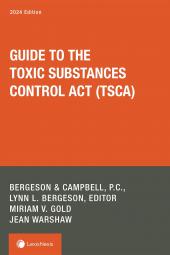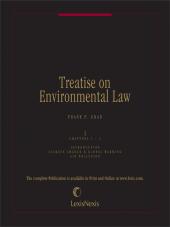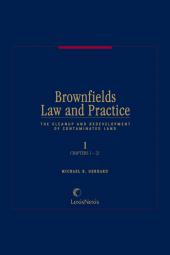We are in the process of migrating the LexisNexis Store. During this transition, some customers may not be able to access their Download Center or new electronic orders. Please call Customer Service 1-800-833-9844 or Chat With A Support Representative <https://supportcenter.lexisnexis.com/app/chat/store_chat/>
Guide to the Toxic Substances Control Act
Select a format
 International Order Inquiry
International Order Inquiry
Select subscription type
Terms & conditions
Subscribers receive the product(s) listed on the Order Form and any Updates made available during the annual subscription period. Shipping and handling fees are not included in the annual price.
Subscribers are advised of the number of Updates that were made to the particular publication the prior year. The number of Updates may vary due to developments in the law and other publishing issues, but subscribers may use this as a rough estimate of future shipments. Subscribers may call Customer Support at 800-833-9844 for additional information.
Subscribers may cancel this subscription by: calling Customer Support at 800-833-9844; emailing customer.support@lexisnexis.com; or returning the invoice marked "CANCEL".
If subscribers cancel within 30 days after the product is ordered or received and return the product at their expense, then they will receive a full credit of the price for the annual subscription.
If subscribers cancel between 31 and 60 days after the invoice date and return the product at their expense, then they will receive a 5/6th credit of the price for the annual subscription. No credit will be given for cancellations more than 60 days after the invoice date. To receive any credit, subscriber must return all product(s) shipped during the year at their expense within the applicable cancellation period listed above.
The total price includes the product(s) listed in the Order Form and any Updates for a limited period (minimum period of 30 days) after the order is placed ("Order Window"). Shipping and handling fees are not included in the grand total price.
All shipments may be returned, at subscribers' expense, for full credit of the Price within 30 days of receipt.
Shipments may not be returned, and no credits will be issued, more than 30 days after receipt.
After the Order Window, subscribers will receive notice of Updates along with the then-current grand total price and order process as Updates become available. Subscribers will only be shipped those Updates they specifically request.
Product description
View a sample of this title using the ReadNow feature
The Toxic Substances Control Act (TSCA), enacted in 1976, provided the U.S. Environmental Protection Agency (EPA) with the first grant of broad authority to gather information on chemical hazards to assess risks across previously unregulated activities and industries and to use that information to regulate the manufacture, import, processing, use, distribution in commerce, and disposal of chemical substances other than foods, drugs, cosmetics, and pesticides. TSCA cuts across all business activities, from research through end of product life, and has a far broader scope than the media-specific environmental statutes passed in the same decade.
TSCA was overhauled in 2016 when the Frank R. Lautenberg Chemical Safety for the 21st Century Act (Lautenberg) was signed into law, changing the basic approach of the law, including the premanufacture notification procedure, treatment of confidential business information, preemption of state laws, and the safety standard by which chemicals are evaluated. EPA is still in the process of issuing new rules and guidance documents to meet its obligations under Lautenberg.
Guide to the Toxic Substances Control Act (formerly known as The Toxic Substances Control Act: Reformed by the Lautenberg Act) is written for lawyers, regulatory affairs specialists, and commercial and business people who need to understand the details of the law and implement both old and new regulations. The 2024 edition, the first under the editorial direction of the TSCA team at Bergeson & Campbell, P.C., the premier law firm focusing on chemical law, regulation, science, and policy, includes detailed descriptions and practice pointers for each of the programs under TSCA.
The past year has been eventful, and this edition is chock-full of new text. EPA has completed more risk evaluations and moved into developing and implementing TSCA Section 6 risk management approaches. EPA has significantly expanded its regulation of per- and polyfluoroalkyl substances (PFAS). EPA issued the TSCA Section 8(a)(7) reporting rule, which is expected to provide EPA with information to assist the Agency in targeting its PFAS TSCA initiatives more specifically. Other Section 8 initiatives are under way. EPA issued a final TSCA Section 8(a) rule for asbestos reporting, has proposed a TSCA Section 8(d) rule to help chemical prioritization, and a TSCA Section 8(c) rule to assist with its risk evaluation efforts. EPA’s deployment of its Section 8 authorities is unprecedented.
Finally, revisions to the new chemical review process are front and center and discussed in detail in this edition. These changes reflect in part Agency efforts to address broad concern with the lengthy delays in processing chemical notifications and the sometimes overly conservative assumptions EPA reviewers apply, resulting in commercially challenging restrictions on new chemical production, distribution, and use. Other important TSCA changes the authors discuss are EPA’s initiatives narrowing opportunities to assert and maintain confidential business information claims, EPA’s revised approach to risk prioritization and evaluation, changes to the TSCA Section 4 testing program, new enforcement policies and practices, and much more.
The previous edition's ISBN is 9781663358691.
eBooks, CDs, downloadable content, and software purchases are noncancelable, nonrefundable and nonreturnable. Click here for more information about LexisNexis eBooks. The eBook versions of this title may feature links to Lexis+® for further legal research options. A valid subscription to Lexis+® is required to access this content.
Table of contents
CHAPTER 1 Introduction
CHAPTER 2 TSCA’s Scope
CHAPTER 3 Concepts of General Applicability
CHAPTER 4 The Inventory
CHAPTER 5 Premanufacture Notifications
CHAPTER 6 PMN Exclusions and Exemptions
CHAPTER 7 Microorganisms
CHAPTER 8 Reporting and Recordkeeping
CHAPTER 9 Exports and Imports
CHAPTER 10 Testing
CHAPTER 11 Prioritization, Risk Evaluation, Bans, and Restrictions
CHAPTER 12 Significant New Use Rules
CHAPTER 13 Penalties and Enforcement
CHAPTER 14 Acquisitions and Divestitures
CHAPTER 15 Resources
TABLE OF CASES
INDEX
 Lexis Nexis
Lexis Nexis 


